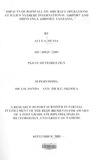| dc.description.abstract | Although air transportation seems to be the best way of travels in Tanzania sometimes it
became unsafely and unreliable due to the different factors including bad weather such as
heavy rains. Bad weather may lead to aircraft accidents, delays, cancellations of flight,
and diversions of flights to other alternate aerodromes. The present study examined the
impacts of rainfall on air transportation at Julius Nyerere International Airport (JNIA)
and Shinyanga airport (HTSY).
The methods that were employed in this study include; time series analysis, graphical
analysis and correlation analysis that used to Study the impacts of rainfall on air
transportation at Julius Nyerere International Airport and Shinyanga airport. In order to
archive this objective the following specific objectives were addressed; to examine the
temporal characteristic of rainfall at JNIA, to identify cases of delaying, cancellation,
diversions of flights due to heavy rainfall and to study the wet spells during a wet season
(Intra Seasonal Oscillations-ISO).
Two data sets were used in this study; Rainfall data and charts of each day for three
months, March, April, and May from 1996 to 2005 and Flight accident reports which
obtained through accidents report files in operation office of Precision Air.
Rainfall analysis used in this study shows that; The wettest season was 2002 for both
stations(JNIA and HTSY) while driest season was 2003 for JNIA and 2000 for HTSY.
April was the wettest month at JNIA But March was the wettest month at HTSY, while
May was the driest month at both stations (JNIA and HTSY). Also rainfall season(MAM)
show that; the mean onset starts on 3rd week of March at both JNIA and HTSY, while
the mean cessation at JNIA is on 4th week of May and at HTSY is on 2nd week of May.
More analysis was done on operation of aircraft on both stations, at JNIA more delays
were in April (5) while at HTSY more delays were observed in March (6), and maximum
number of cancellation (39) occurred at HTSY.
Although rains cause some cancellations and delays of flights, but it is not a main cause
of aircraft accidents in Tanzania.
The results obtained from rain data and operation of aircraft showed there are more
correlations between rain days and delays of flights at both airports (JNIA &HTSY), also
some correlations are observed on rain days and cancellations of flights at HTSY.
In order to solve the problems of most cancellations, the construction of paved (tarmac)
runways is required; also the problem of delays of flights can be solved by relating flights
planning with daily weather forecasts and Terminal Aerodromes Forecasts (TAF). | en |

